Effective Dance Stretches for Maximum Flexibility
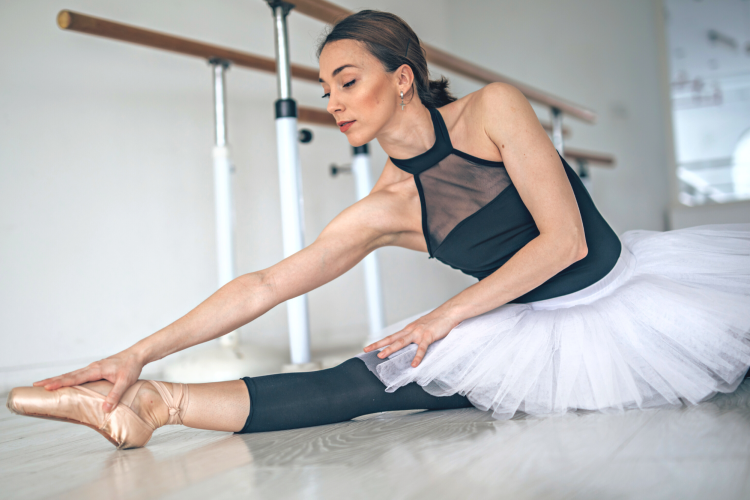
Everyone can benefit from incorporating dance stretches into their daily routines. Whether you are a professional dancer, dance for fun or exercise, or just need a way to keep your body moving efficiently, adding dance stretches into your daily regimen benefits both your body and mind.
Dancing is a total body activity that requires flexibility from the neck and shoulders to the legs and feet. Practicing dance stretches helps with a variety of goals from relieving tension in the low back to achieving full splits.
Learning the right way to stretch and tend to your body is fundamental to increasing your flexibility and reaping the many benefits of dance stretches as you work toward your goals.
So, what are the most effective dance stretches for flexibility? Whether you are a new dancer or looking for ways to deepen your stretches, here are some beginner to advanced dance stretches and stretching tips to add to your routine.
Jump to Section
- How Do Dancers Become Flexible?
- Benefits of Dancer Stretch Routines
- How Long Should Dancers Stretch?
- Best Ballet Stretches for Beginners
- Best Dance Stretches for Splits
- Best Back Stretches for Dancers
- Deep Stretches for Dancers
How Do Dancers Become Flexible?
Whether working toward the lyrical movement of a ballerina or the sharp twists and pops of a hip-hop routine, improving flexibility with effective dance stretches is a crucial part of any dancer’s workout.
Understanding when and how long to stretch is just as important as the types of stretches in your routine with thoughtful and consistent stretching being the keys to successful improvement.
When building your dancer stretch routine, aim for 10-20 minutes five or six days a week with targeted stretches for troublesome areas such as the hamstrings, hip flexors or low back.
Strength and Flexibility Dance Classes
For guided practice in dance stretches, try joining a stretch-focused dance class, like pilates, barre or flexibility workouts.
There are a variety of in-person classes across the country including dance classes in Houston, dance classes in Seattle, dance classes in Las Vegas and dance classes near you with top-of-the-line instructors who will help with stretching, training and performing different styles of dance.
If you prefer to practice your dance stretches from home, online dance classes are also available for all skill levels from beginner basics to choreographed routines. Gaining these skills will help you ultimately learn other dance forms, like how to slow dance, how to belly dance and more. If you're unsure which class they want to get, get them a Classpop! gift card so they can choose!

Benefits of Dancer Stretch Routines
Physical Benefits of Stretching
Decades of research have shown a wealth of benefits that can be achieved through consistent stretching. As described in Healthline, routine stretching can increase flexibility and range of motion, improve performance in physical activities, increase blood flow to the muscles, improve posture and help heal and prevent back pain.
Practicing dance stretches on a regular basis helps protect the body from injury, enables muscles to work more effectively and relieves pain and stiffness.
Mental Benefits of Stretching
In addition to these physical benefits, daily stretching has also been shown to benefit the mind. Bryan Adams-Colon of Colorado State University explains that regular stretching can improve mental health by reducing muscle tension and increasing serotonin levels in the body resulting in decreased depression and anxiety.
Counteracting the physical and mental stresses of our day with consistent stretching protects the body and mind through dynamic physical activity, intense mental or emotional stress and even throughout the aging process.
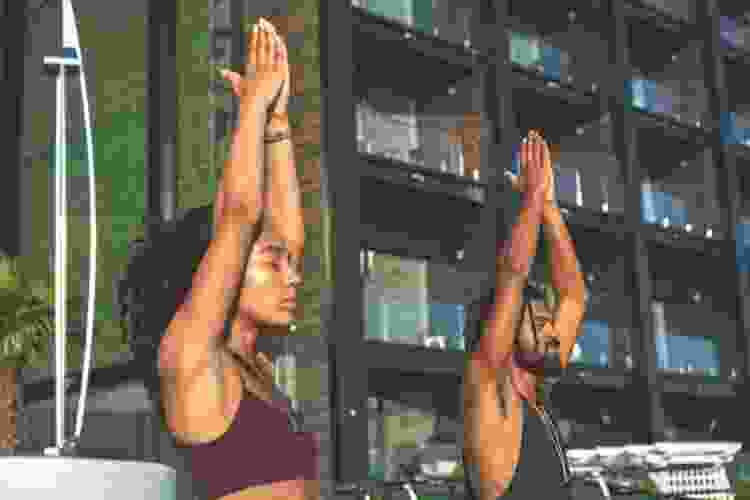
How Long Should Dancers Stretch?
In order to reap the benefits of your dance stretches, you should understand when and how long to stretch. Different types of dance stretches are best suited for different parts of your workout.
Start With a Warm-Up
Before dancing or any physical activity, you should make sure your body is warmed up by performing light cardio such as a brisk walk to get the heart rate up or dynamic stretches like a yoga flow.
It is important to get the blood flowing before practicing static dance stretches to protect yourself from pain or injury. Static stretching at the end of exercise while the muscles are still warm helps increase overall range of motion and flexibility.
Set Goals for Timed Stretching
For those new to dance stretches, begin with a goal of stretching for about five to 10 minutes four times a week holding each position for about 15 seconds. As you become more comfortable with dance stretches, you can increase your time spent stretching and total number of days per week.
Tip: Take your time and listen to your body, making sure to avoid overstretching and giving your muscles adequate space to rest and recover.
Get Into a Routine
Once you have developed a consistent habit of performing your dance stretches, you might choose to work toward stretching your biggest problem areas up to five times a day, six days a week, holding each stretch for up to 30 seconds.
Especially for dancers, total body stretching should be incorporated into your regular regimen of dance stretches by actively stretching each muscle group from top to bottom. Only stretching tight muscles while neglecting the rest can leave you imbalanced and vulnerable to injury.

Best Ballet Stretches for Beginners
Developing an effective routine of dancer stretches can improve flexibility quickly and safely so dancers can achieve the flowing movements and extensions signature of ballet.
Many of the dance stretches recommended for beginners of ballet are also beneficial for non-dancers who want to become more flexible and increase or maintain range of motion.
Here are some suggested dance stretches for beginners that address most of the commonly utilized muscles in ballet.
Upper Body Stretches
Neck Stretch
- This dance stretch focuses on mobility of the head and neck.
- Stand straight with your arms at your sides, then tilt your ear toward your shoulder and hold for five to 10 seconds.
- Repeat on the other side.
- For a deeper stretch, gently place your hand over your head to your opposite ear applying slight pressure.
Shoulder and Arm Stretches
- These dance stretches help loosen and protect your shoulder joints while elongating the muscles of the arms.
- For a classic arm stretch, extend one arm and use your opposite arm to guide it across the front of the chest and hold. Repeat on the opposite side. You should feel a stretch on the back of the shoulder.
- Another option is to hold your elbow with your opposite hand and guide the arm across the body, repeating on each side.
- A third option stretches the upper body, shoulders and triceps. Lift one arm above your head and bend it behind you, reaching for the space between your shoulder blades.
- You can use your opposite hand on your elbow to guide the arm into a deeper stretch.
Shoulder Squeeze
- This dance stretch targets the front of the shoulders, arms and chest while relieving tension in the back.
- Clasp your hands behind your low back, then straighten and extend your arms.
- Squeeze your shoulder blades together and hold for a few seconds, then release and repeat several times.
- For a deeper stretch, gently tilt your chin toward your chest.
Side Stretch
- Those signature elongated movements of ballet often start from the core.
- To stretch the muscles around and between your ribs and torso, extend your arm straight above your head and slowly lean to the opposite side.
- Repeat on the other side.
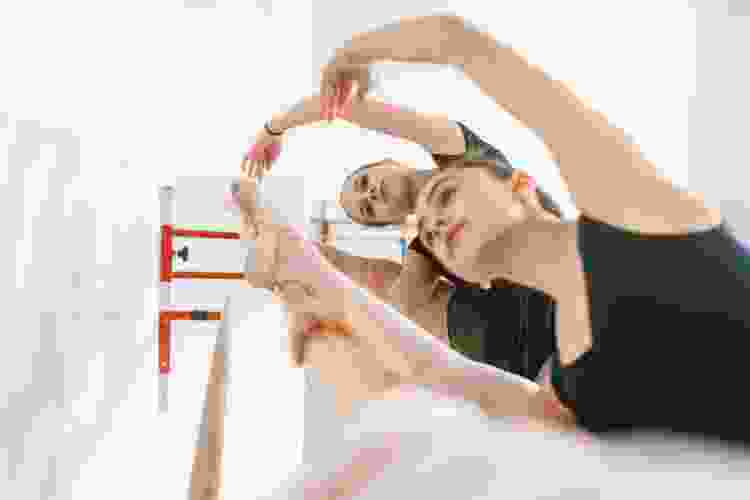
Hip Openers and Low Back Stretches
Low Lunge
- This flexibility dance stretch addresses the hip flexors, groin and quads.
- Kneel in a deep lunge with your back leg on the floor and front knee aligned over front ankle. Adjust as needed until you feel a comfortable stretch around the front of your hip and quad of the back leg.
- Hold for about 30 seconds and repeat on the other side.
- For a deeper stretch and added attention to the torso and low back, add a twist on each side by turning your chest toward your front knee.
Butterfly
- This dance stretch helps improve flexibility in the hips, glutes, back and thighs.
- Sit on the floor with your back straight and the bottoms of your feet pressing together with knees bent out to the sides.
- Grasp your ankles or feet and slowly lower your chest toward your feet while pressing your knees toward the floor.
Frog
- Frog is one of the best hip opening dance stretches and a counterbalance to sitting with crossed legs.
- This stretch can be a bit challenging for beginners, so be gentle when attempting it for the first time.
- Start on all fours, then slide your knees wider than shoulder width apart. Turn your toes out and lower your inner thighs to rest on the floor. Shift your hips back toward your heels while keeping your feet pressed against the floor.
- For a deeper stretch, you can lower to your forearms.
Piriformis Stretch
- The piriformis muscle is a small muscle located behind the glute that starts at the lower spine and connects to the upper thighbone. This muscle is critical to hip rotation and turning out the leg and foot.
- To perform this dance stretch, lay on your back with your knees bent and feet on the floor. Place your right ankle over your left knee. Reach behind your left thigh and gently pull your knee toward your chest until you feel a stretch around your glute.
- For a deeper stretch, use your right elbow to press against your right thigh. Hold for about 30 seconds and repeat on the opposite side.
Standing or Seated Forward Fold
- These dance stretches relieve tension in the low back while providing a stretch in the hamstrings.
- Start in a standing or seated position, making sure not to lock your knees, with your back straight.
- Slowly bend forward leading with the chest and keeping the back straight as you reach toward your toes.
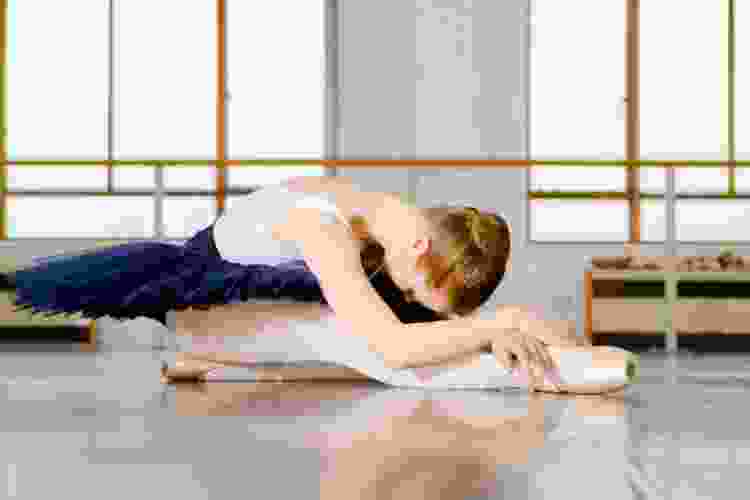
Lower Body Stretches
Quad Stretch
- Dance stretches for the lower body including the quads, hamstrings, calves and ankles are essential to building a strong and flexible foundation for performing ballet.
- In a standing position, lift your heel toward your behind, holding your foot with your hand. You should feel a stretch in the front of your thigh.
- Repeat on the opposite side.
Calf and Ankle Stretches
- Tight calves restrict the movement of the feet and ankles, so it is important for ballet dancers to spend time stretching these muscles.
- For a standing calf dance stretch, use a wall for support. Stand with one foot behind you and the other bent in front of you, keeping your heels on the floor.
- Place both hands on the wall and lean forward until you feel a stretch in your calf and the back of the ankle. Hold for about 30 seconds and repeat on the other side.
- You can also stretch your ankles by lying on your back with one leg raised straight toward the ceiling. Alternate pointing and flexing your foot three to five times, holding for a few seconds each, then switch to the other leg.
- You can also add in rotating each ankle clockwise and counterclockwise to help increase range of motion.
Standing Hamstring Stretch
- This flexibility dance stretch focuses on the low back, glutes, hamstrings and calves.
- Start by standing with feet hip width apart, then step one foot forward.
- Similar to a forward fold, slowly bend toward the floor making sure not to lock the knees.
- Switch legs and repeat on the other side.
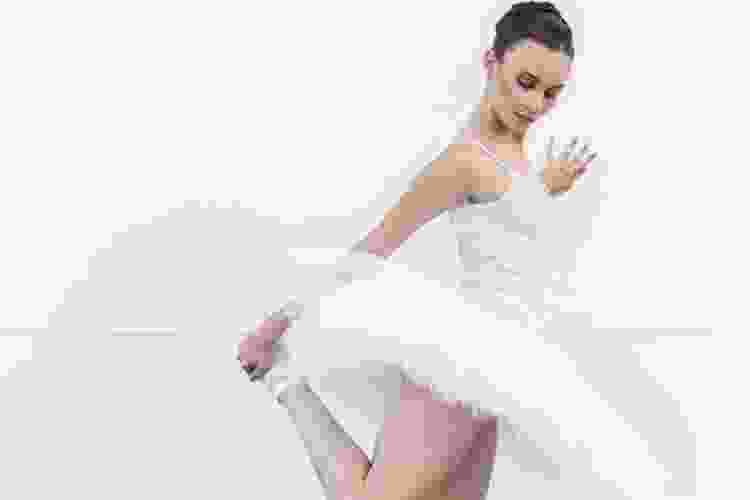
Best Dance Stretches for Splits
Being able to perform splits is a common goal for dancers and an important foundation for a number of ballet techniques. Consistently practicing several of the aforementioned beginner dance stretches will have you on your way to performing splits. However, there are a few additional ballet stretches that will target the muscle groups to get you there safely and efficiently.
Pigeon
- Again borrowing from yoga, pigeon pose helps to improve flexibility in the hip flexors and low back.
- Begin on all fours, then bring your right knee forward. Turn your knee out to the right with your shin facing forward. Gently lower your left knee to the floor, adjusting until you feel a stretch in your hip and glute.
- Make sure your left leg is pointing straight back with your hips squared toward the front. Carefully release and repeat on the opposite side.
- For a deeper stretch, lower to your forearms, or depending on your range of motion, lower your head toward the ground.
Lizard
- Another hip opener grounded in yoga, lizard pose can be an intense stretch that may help you achieve full splits by focusing on the hip flexors, hamstrings and quads.
- Begin on all fours, then step your right foot forward to the outside of your right hand. Make sure your knee is stacked over your ankle with your toes slightly turned out.
- Extend your left leg back and lower your thigh toward the floor.
- For a deeper stretch, lower to your forearms and press into your heel to keep the front leg active.
Supported Splits
- Once you have gained enough flexibility in your hips, legs and back, practicing the supported splits dance stretch is a great way to ease into full splits.
- Using a block or other form of support, begin in a lizard pose. Shift your weight back, straightening your front leg over the support.
- Slowly adjust your feet away from you, allowing your weight to rest on the support, as you come closer to your full split.
Standing Splits
- A more advanced dance stretch on the way to full splits is the standing split. This is a level up from a forward fold that targets the quads and hamstrings while also challenging your balance.
- This dance stretch requires core strength and attention to the rotation of the hips.
- Begin in forward fold, making sure not to lock your knees, then shift your weight to one foot and raise the other leg as high as you can behind you.
- Walk your hands toward the heel of your standing foot, drawing your torso closer to your leg. Square your hips toward the floor and keep your standing leg facing forward.
- Hold and slowly lower your leg before repeating the stretch on the other leg.
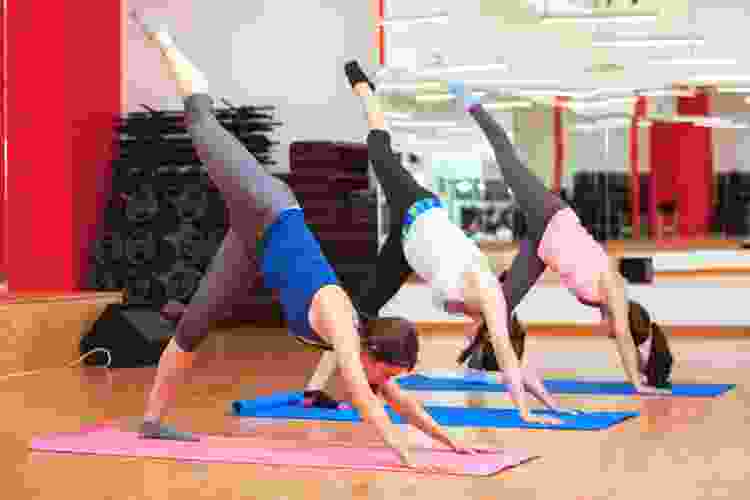
Best Back Stretches for Dancers
Tending to the back and the muscles that support and protect the spine is just as critical for dancers as being able to elongate the arms and legs or gliding into full splits.
As the starting point of many of the body’s movements, building a strong and flexible core can enhance your performance and help protect you from pain or injury.
In addition to the beginner dance stretches that address tension in the back, there are a number of dance stretches you can practice to further increase flexibility and mobility in your back.
Cat-Cow
- Excellent for spinal flexion, the Cat-Cow dance stretch helps improve mobility and relieve tension in the neck, back and shoulders.
- Begin on all fours with your hands below your shoulders with a flat back. Lower into the cow part of the stretch by dropping your stomach toward the floor and arching your back while keeping your hips and shoulders in the same position.
- Moving with your breath through the flat back starting position, push your spine toward the ceiling into the cat part of the stretch.
- Repeat a few times, moving slowly through cat and cow.
Cobra
- Releasing tension in the low back and hamstrings, cobra also helps stretch the muscles of the torso.
- Start on all fours, then lift your hips, shift forward and lower to the ground.
- Straighten your arms, keeping your hips pressing toward the floor.
- Arch your back and look forward, feeling the stretch in your legs and core.
Camel
- This dance stretch helps to stretch the front of the body while strengthening the back. It is a great counterbalance to sitting, slouching or bending forward.
- Begin kneeling with your body upright and hips stacked over the knees. With your hands on the back of your hips, lift your chest toward the ceiling.
- Slowly reach back to grasp your heels with your hands, starting with one at a time, as you let your hips come forward and arch your back gently as you look up.
- Hold for up to 30 seconds and slowly release by dropping your chin toward your chest and using your core to return to an upright position.
Scorpion
- This advanced dance stretch targets the hips and lower back while also improving spinal rotation. Safely incorporating twists into your stretching routine is a great way to improve mobility and range of motion throughout the body.
- Lie facedown with your legs extended behind you and arms stretched out to either side.
- Press your palms against the floor for stability in the upper body as you lift one leg off of the ground, bend the knee to about a 90 degree angle and rotate the leg toward the opposite side of the body.
- Reach your foot toward the ground as you feel the stretch in your back, hip and quad.
Supine Twists
- Lie with your back on the floor with your arms extended out to each side in a T.
- Bring your knees up, creating a 90 degree angle with your legs. Slowly lower your legs to one side keeping your back and shoulder pressing flat against the floor.
- You should feel a stretch in the opposite side of your back and torso. Slowly return to the center before lowering your legs to the opposite side.
- For a deeper stretch, turn your head to the opposite direction of your knees and/or cross your bottom ankle over your top thigh.
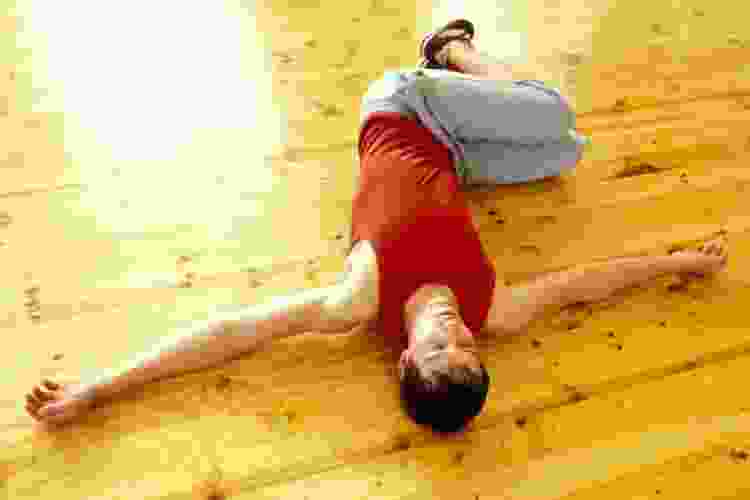
Deep Stretches for Dancers
Although advanced dance stretches can be incorporated into your routine once your body has the required flexibility and strength, there are a few tips to follow that can give you a deep stretch even in beginner positions.
Focus on Breathing
Possibly the most important technique to achieving a deep dance stretch is remembering to breathe. Conscious breathing helps you relax and move deeper into each stretch.
When performing dynamic stretches, practice moving with your breath to assist the muscles as they elongate and flex. As you become more familiar with how to safely perform each stretch, focus on your form and be sure not to rush through the routine.
Improve Strength With Tools and Training
While working toward more advanced dance stretches, it may be beneficial to consider incorporating strength training and learning flexibility exercises for dancers to help build support throughout your body in order to allow you to safely perform deeper and more difficult stretches.
Finally, with a few simple variations or assistive tools, you can achieve deeper stretches. Try using a towel or band to help guide you into a deeper extension or ask a partner to provide resistance.
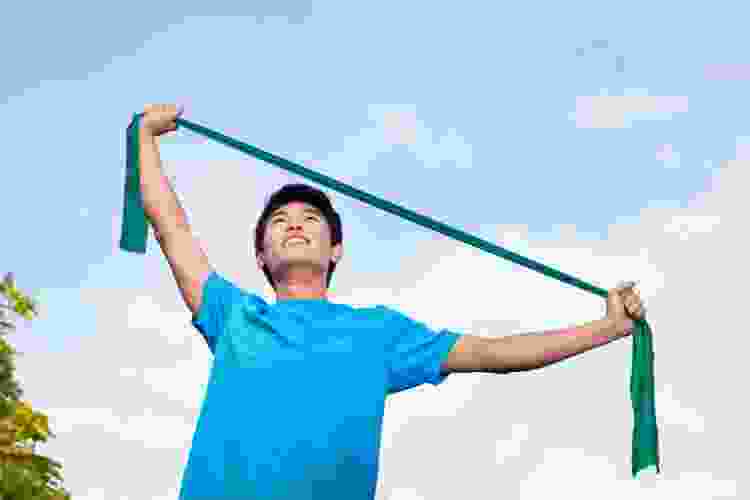
From new dancers to prima ballerinas, a thorough and consistent routine of effective dance stretches is essential to maintaining the flexibility and mobility to perform. Learning how to stretch like a dancer offers physical and mental benefits even as you grow and age.
Now that you are more familiar with a variety of dance stretches to try, you can safely work toward your flexibility goals on your own or in a class with the guidance of a talented dance instructor.
For even more creative ideas and inspiration, check out other experiences happening on Classpop!

